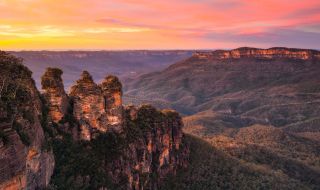
- NSW Road trips
- Accommodation
- Be inspired

- travel information

Getting around Sydney
An efficient network of transport options connects the attractions and suburbs of Sydney and regional NSW, including buses, trains, ferries and light rail.
Sydney public transport
Transport for NSW provides a variety of ways to get around the city, as well as information for motorists. Use the trip planner at transportnsw.info to plan your travel.
Opal card info
The Opal card is an easy, convenient way of paying for your travel on public transport in Sydney. It can be used on all public transport, including trains, ferries, buses and light rail. There are daily and weekly caps on the Opal network, meaning you can travel as much as you like within the Opal network and you never pay more than the capped fare. The Sydney Airport station access fee isn’t included in the travel caps.
Opal cards can be obtained from train stations and the domestic and international airport, as well as many retailers across the city. For more information, visit opal.com.au.
You can also pay with contactless-enabled American Express, Mastercard or Visa credit or debit cards or a linked device, by tapping on and tapping off at Opal readers. Contactless payments are available on all public transport in the Opal network and you will receive the same travel benefits of an Adult Opal card.
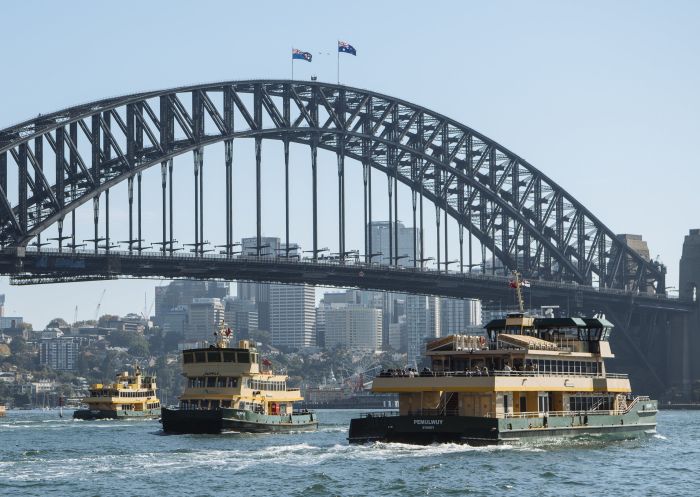
Ferries on Sydney Harbour
Sydney buses
Buses form a key part of Sydney’s public transport system, connecting all areas of the city, including those without rail or water transport. There are also NightRide services replacing most train routes between midnight and 4:30am.
Key bus routes include:
- 333 – Connecting Circular Quay to Bondi
- B1 – Wynyard to Mona Vale
- 373 – Connecting Museum to Coogee
- 380 - Watsons Bay to Bondi Junction
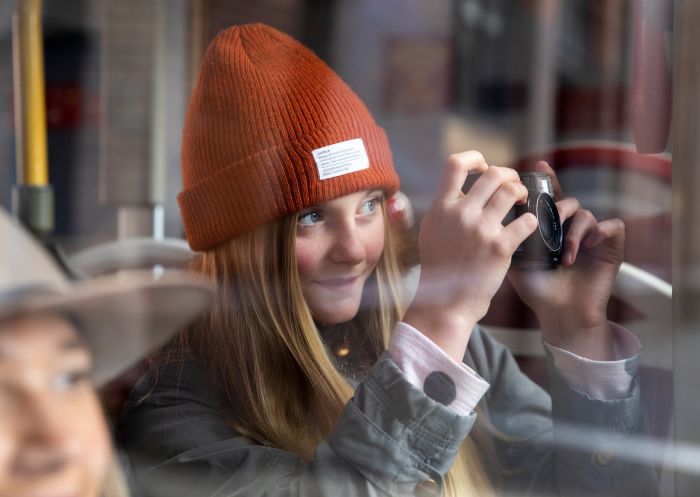
Family enjoying a guided tour of Sydney with Big Red Bus Tours, Sydney
Sydney rail
Sydney's main terminus for local and regional trains and buses is Central Station at Railway Square, close to Chinatown. Trains operate North to the CBD and across the harbour to North Sydney and beyond, as well as east to Bondi Junction and South past and including Sydney Airport. Sydney train maps and train timetables can be found at Transport NSW .
Sydney light rail
The L1 Inner West Light Rail network operates in both directions between Central Station and Dulwich Hill in Sydney’s West. The CBD and South East Light Rail includes the L2 Randwick Line connecting Circular Quay to Randwick and the L3 Kingsford Line between Circular Quay and Junior Kingsford. Visit Transport NSW for more information and for a Sydney Light Rail map.
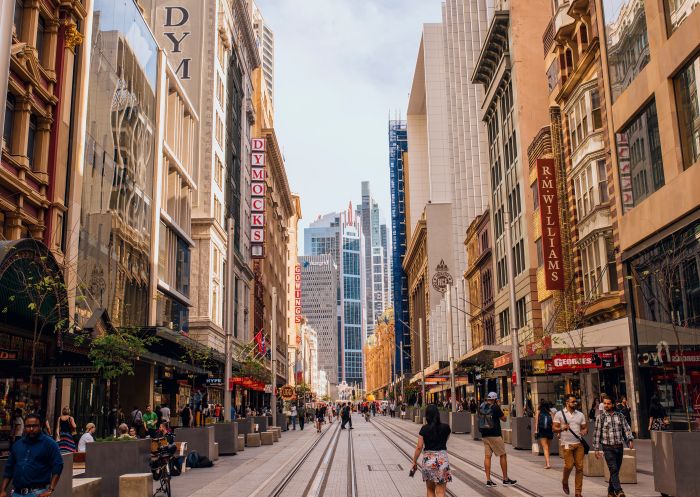
Tramlines running down George Street, Sydney CBD
Sydney ferries
Ferries provide a fast and convenient way to cross the harbour, as well as offering a fantastic vantage point of the city. From Circular Quay you can take the Manly Fast Ferry or F1 to Manly, the F2 to Taronga Zoo and the F4 to Watsons Bay and Rose Bay.
Captain Cook also operates ferries between various locations including between Watsons Bay and Manly, Circular Quay and Clifton Gardens and from Circular Quay to Shark Island.
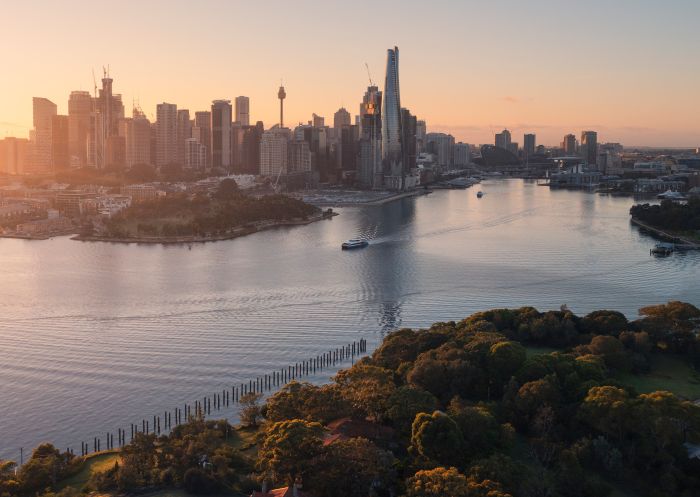
View at sunrise of Goat Island , Sydney Harbour
River ferries
The river ferry travels up the Parramatta River from Circular Quay to Parramatta, with stops along the way including Cockatoo Island, Cabarita and Sydney Olympic Park. The full journey takes about 90 minutes depending on stops.

Friendship Ferry cruising under Sydney Harbour Bridge , Sydney Harbour
Cycling
A bicycle is a great way to get around Sydney. Cyclists use kerbside bike lanes and are permitted on most of Sydney's multi-lane roads. Find Sydney cycle maps, routes and more information .
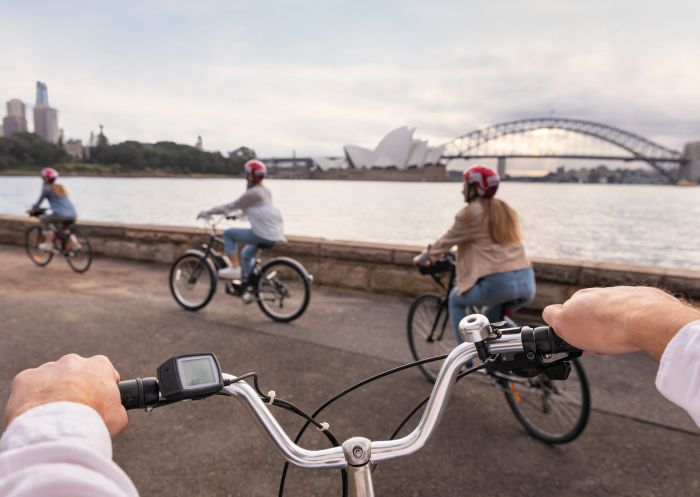
Bonza Bike Tours , Royal Botanic Garden
Driving in Sydney
Australians drive on the left-hand side of the road. If you’re travelling from overseas, you are able to drive in Australia with your foreign driver's licence for three months, as long as that licence is in English. If your licence is not in English, you will need to attain an International Drivers Permit (IDP) to use in Australia.
Seat belts are compulsory in Australia, with the driver responsible for ensuring all passengers are wearing them. Using hand-held mobile phones is prohibited. The blood alcohol limit is 0.05% throughout Australia and is enforced with random breath tests. Pay attention to speed limits – speed cameras are used across Sydney and NSW.
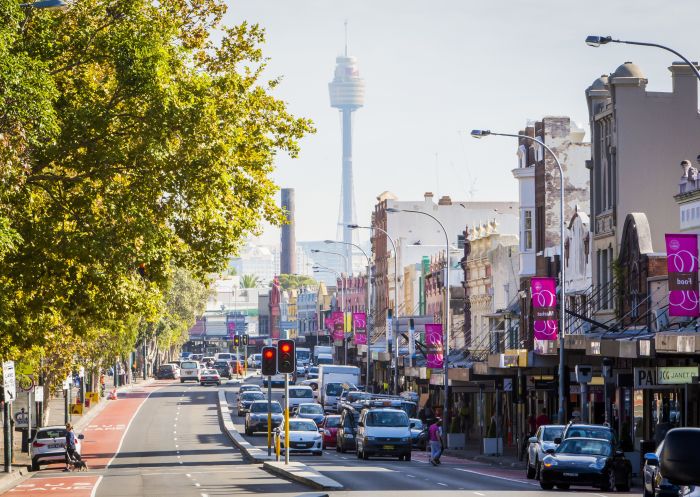
Shops and cafes lined up along Oxford Street, Paddington
Parking in Sydney
Parking can be limited and expensive in the CBD and close to popular beaches. Many of Sydney’s streets are restricted to permit holders, with time limits applied to non-permit holders or with metered parking. Fees range from $2.50 to $8 per hour depending on the location and time of day.
The cheapest way to park in the city centre is to pre-book online. Secure and Wilson parking offer cheaper advance rates and parkopedia.com is also a useful resource when looking for parking. If parking on the street, ensure you park in line with traffic.
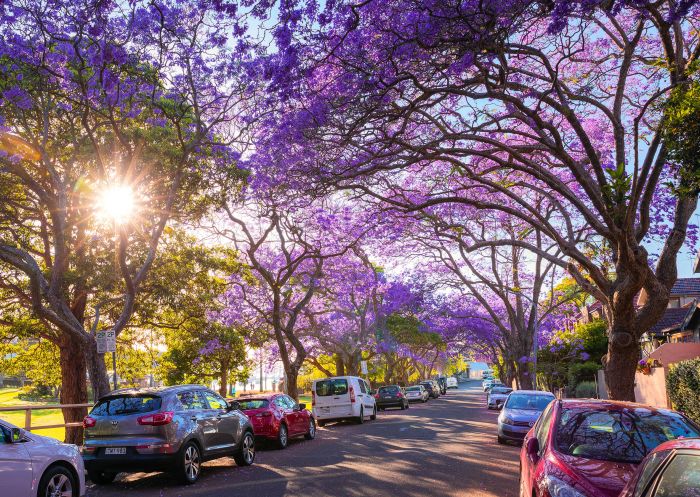
Jacaranda trees in full bloom along McDougall Street, Kirribilli
Toll roads
Sydney has a number of toll roads and tunnels, including the Harbour Bridge, Harbour Tunnel, Cross City Tunnel and Eastern Distributor. This is charged via an electronic system. If you have a rental car, it will most likely have an e-tag installed and you will be billed at a later date. If you don’t have an e-tag, you can obtain one from the following websites:
roam.com.au
linkt.com.au
myetoll.com.au
If you pass through a toll road without a tag, ensure you call the number advertised to pay the toll, otherwise, you may incur a fine.

The Cahill Expressway, Sydney CBD
Car rentals in Sydney
You’ll find a range of car rental options in Sydney, including car, 4WD, campervan and classic car hire .
Electric vehicle charging points
Electric vehicle charging points can be found across Sydney and NSW. Make sure you check their locations before setting out on your journey. You can find a full list on the Electric Vehicle Council website .
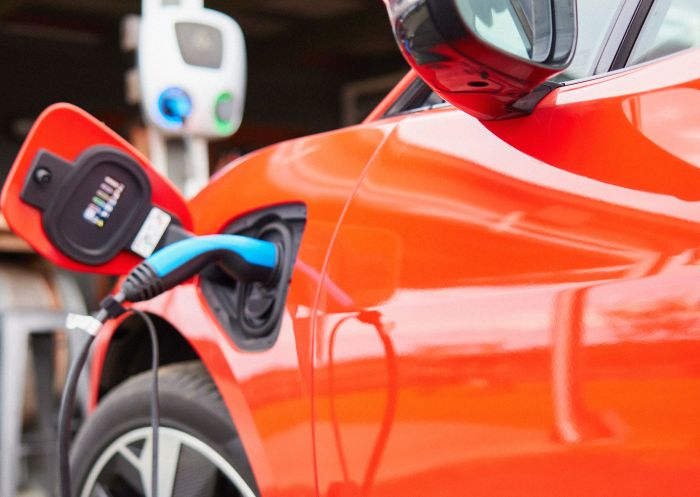
Electric car charger at Mountain Ridge Wines, Coolangatta
Taxis & private transport
Taxis and water taxis are a convenient way to get around Sydney. Rideshare services also operate in Sydney and include Uber, Ola and Didi.
- Legion Cabs : 13 14 51
- Premier Cabs : 13 10 17
- Silver Service Cabs : 13 31 00
- St George Cabs : 13 21 66
- 13CABS : 13 22 27
- Wheelchair Accessible Taxis (WATS)
- Water Taxis Combined : 02 9555 8888
- V.I.P Water Taxis : 0418 847 777
- Majestic Water Taxi : 0439 625 377
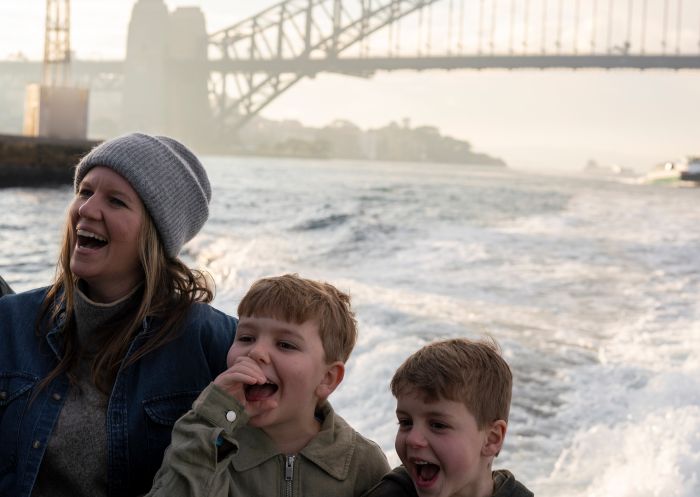
Family enjoying the views aboard a Majestic Water Taxi, Sydney Harbour
Travelling beyond Sydney
Sydney airport .
Sydney Airport is located about 9 kilometres south of Sydney's city centre in the suburb of Mascot.
The three passenger terminals at Sydney Airport are:
- T1: International Terminal is used for international flights.
- T2: Domestic Terminal is used by domestic and regional airlines including Jetstar , Rex , Virgin Australia and FlyPelican .
- T3: Domestic Terminal is used for Qantas and QantasLink domestic flights.
Transport services such as buses, taxis, car hire, rail and shuttle bus services are conveniently located at Sydney Airport.
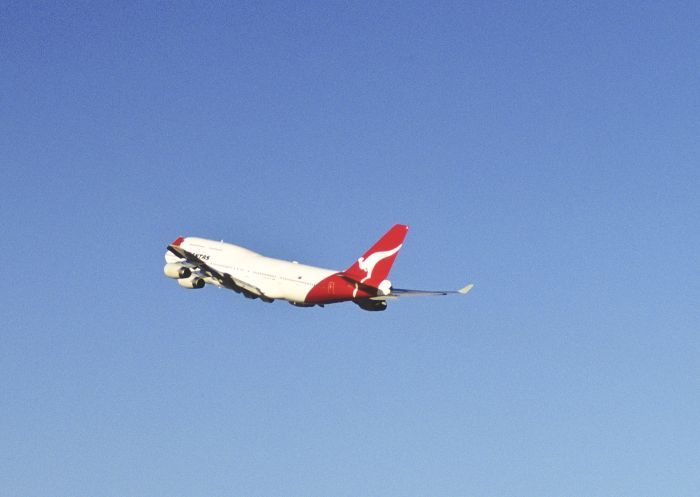
Qantas plane taking off from the airport, Sydney Airport
Sydney cruise terminals
There are two cruise ship terminals in Sydney Harbour. The main Overseas Passenger Terminal is on Circular Quay’s western side in the historic Rocks and opposite the Sydney Opera House. The White Bay Cruise Terminal is near Anzac Bridge and is best accessed from James Craig Road in Rozelle.
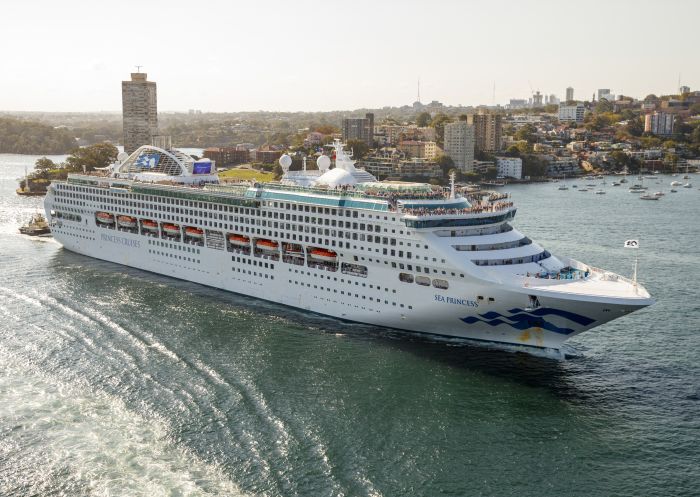
The Sea Princess cruise, Sydney Harbour
Intercity & Country NSW trains
Trains depart Central Station for many NSW destinations, including the South Coast, Blue Mountains, Southern Highlands, Central Coast, North Coast, Country NSW and Outback NSW. Travelling long distances is easy and affordable on regional train and coach services .
Regional bus services
Private bus companies run daily services along the coast and to regional NSW, as well as to other states from Sydney CBD and Central Station.
- Firefly Express : 1300 730 740 within Australia
- Greyhound : +61 13 14 99
- Murrays : +61 13 22 51
- Priors Scenic Express : 1800 816 234 within Australia
Accessible transport
All ferries, trains and new buses in NSW are wheelchair accessible, providing easy access for prams and other mobility devices. You can ask for assistance boarding or leaving transport. Visit Transport for NSW’s accessible travel web page for more information.
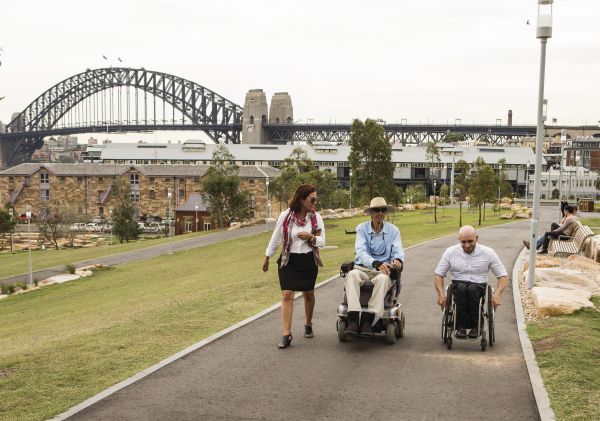
Opal Card FAQs
How does the opal card work.
Opal cards are essentially smartcard tickets used to pay for travel on public transport in Sydney. To use the Opal card, you must first load value onto it. Then at the start of your journey, you tap on at a designated Opal card reader. When you arrive at your destination, you tap off, in the same way that you tapped on, and the designated Opal card reader will display your fare. The fare is calculated according to the distance you have travelled and it is automatically deducted from the value on your Opal card account (or charged to your contactless payment card). Opal cards are reusable and must be reloaded once your account reaches low figures to continue using public transport in the Opal system network.
How much is an Opal card?
There is no charge for an Opal card. However, when obtaining an Adult Opal card, the minimum value of $20 must be loaded onto the card. This amount is then used to pay future fares on the Opal network. The minimum value for a Child/Youth Opal card is $10 and this amount can also be used in the same way as an Adult Opal Card, to pay for future fares on the Opal network.
Where can I buy an Opal card?
Opal cards can be purchased over the counter from Opal retailers, this includes convenience stores, grocery stores, newsagents and pharmacies. Look for the Opal symbol at shops in your area to locate an Opal card retailer.
How do I top up my Opal card?
There are many ways to top up your Opal card. The most convenient way is by logging into your account or through the Opal Travel app, registering your Opal card to your account, adding a debit or credit card and setting up an automatic top up. When your Opal card balance reaches a certain minimum value, it will automatically add a set amount by charging your card. If you prefer to do manual top ups, this can also be done through the Opal Travel app or by logging onto your account. Additionally, you can top up your Opal card over the counter at Opal retailers or the Opal top up machines available at selected stations, stops and wharves.
Can I use my credit card instead of my Opal card?
Yes, you can use your credit card to tap on and off the Opal network system as an alternative to travelling with an Adult Opal card. American Express, Mastercard and Visa debit cards with the contactless payment symbol are also other accepted forms of contactless payments. Using any of these payment methods, you will be charged the same Adult Opal fare as you would be charged using your Opal card.
If you have more than one payment method on your mobile device, ensure you use the same card to tap on and off the Opal system to avoid being charged the maximum default fare.
Can you use your phone as an Opal card?
Opal cards do not come in a digital form, but you can use your iPhone (or other smart device) to tap on and off the Opal system network and pay for the fare from your digital wallets using contactless payments. Select the card you want to charge the fare to in your digital wallet and tap onto the designated Opal card reader. The Opal reader will show a “tap success” message to signify that payment has been accepted. At the end of your journey, hold the same device you tapped on with over the Opal reader until you see the confirmation that payment has been accepted.
Is there a discount for children using Opal cards?
Yes, there are Child/Youth Opal cards that are available for children aged 4-15 years of age. Child/Youth Opal cards can also be used by full time NSW and ACT students, aged 16 and older, with a current NSW secondary student concession card. Child/Youth Opal cards can be purchased from Opal retailers or can be applied for online. The Child/Youth Opal cards provides children with discounted fares on the Opal system network. Children under the age of three travel for free on the Opal network. Contactless fares are charged at the equivalent of an Adult Opal ticket, even if used by a child or youth.
What happens if I forget to tap on or tap off with my Opal card?
If you forget to tap on at the beginning of your journey, but tap off at the end of your trip, you will be charged the default fare for an incomplete trip. Similarly, if you tap on, but do not tap off at the end of your journey, you will also be charged the default fare amount.
The amount of a default fare varies depending on the transportation taken:
The default bus fare is $4.71.
The default fare on the ferry is $7.51.
The default fare using the light rail is $3.66.
The default fare for trains is $8.69.
Can two people use the same Opal card?
Only one Opal card can be used on one trip at a time. You must not tap on twice with the same Opal card to pay for another person’s trip. Technically, you can share an Opal card as long as you are not riding on the same trip. Two individual cards are needed if you plan to travel at the same time.
What happens if I lose my Opal card?
If your registered Opal card has been lost, stolen or damaged, you can transfer the balance to another Opal card that is also registered to you. However, if you do not obtain a new Opal card and register it to your account, you will only be able to block the original lost, stolen or damaged Opal card.
Once you have your new Opal card, you can request the balance from the lost, stolen or damaged Opal card to be transferred to your new card. Call 13 67 25 to request the balance from the original card to be transferred to your new card.
Does Opal offer any discounts?
Yes, there are a number of benefits when you travel in the Opal network with an Opal card or credit or debit card.
Daily travel caps - travel all day in the Opal network and never pay more than $16.80 a day for Adult, $8.40 a day for Child/Youth and Concession and $2.50 a day for Gold Senior/Pensioner.
Weekly travel caps - travel all week in the Opal network and never pay more than $50 a week for Adult, $25 a week for Child/Youth and Concession and $17.50 a week for Gold Senior/Pensioner
Weekend travel cap - travel all day on Saturday, Sunday and public holidays and never pay more than $8.40 a day for Adult, $4.20 a day for Child/Youth or Concession and $2.50 a day for Gold Senior/Pensioner
Weekly Travel Rewards - if you have paid for eight journeys in one week (Monday to Sunday), your fares will be half price for the rest of the week.
30% discount with off-peak metro/train/bus/light rail fares - when you travel outside of peak times with your Opal card.
Opal Transfer Discount - when travelling with more than one mode of transport on the same journey (train, ferry, bus or light rail), a $2 discount (adults) is applied to each transfer, within 60 minutes from the last tap off.
Travel apps & information
Live traffic nsw app .
Receive up to the minute news of road incidents and conditions that may affect your journey in Sydney and the NSW regions.
Download the Live Traffic NSW App from the App Store
Download the Live Traffic NSW App from Google Play
TripView
TripView displays Sydney train, bus, ferry and light rail timetables, showing your next services. By TripView Pty Ltd.
Download TripView from the App Store
Download TripView from Google Play

Subscribe to our newsletter
Stay connected to Sydney for all the latest news, stories, upcoming events and travel inspiration.
Discover Somewhere New
All the insider news, tips and inspiration you need to plan your next trip, delivered straight to your inbox.
Destination NSW acknowledges and respects Aboriginal people as the state’s first people and nations and recognises Aboriginal people as the Traditional Owners and occupants of New South Wales land and water.
- NSW Government
- Destination New South Wales (Corporate site)
Sydney.com is the official tourism site for Destination NSW. © Copyright 2024 Destination NSW. All rights reserved
How can we help you today?
Popular searches.
- Contactless payments
- Routes and timetables
- Concessions
- School student travel
- Opal Travel app
- Best Time to Visit
- Weather & Climate
- Sydney Airport Guide
- Neighborhoods to Know
- Public Transportation
- 48-Hour Itinerary
- Day Trips From Sydney
- Top Things to Do
- Best Beaches
- Museums to Visit
- Parks in Sydney
- Shopping Guide
- Must-Try Food
- Best Restaurants
- Nightlife Guide
- Search Please fill out this field.
- Newsletters
- Australia & New Zealand

Getting Around Sydney: Guide to Public Transportation
:max_bytes(150000):strip_icc():format(webp)/IMG_2751-c8e99122470c4e26861511881ad3a6cd.jpg)
As a sprawling, beachside state capital with more than five million residents, public transport is essential for Sydney. The city is Australia's leading public transport hub, with 20.9 percent of residents using it to travel to work in 2016, compared to 13.4 percent of Melbourne residents. The public transport in Sydney has steadily improved over the past decade as the city has become less reliant on driving.
Sydney's public transport network is made up of regular trains, buses, ferries, light rail, and the newly opened driverless Metro line. Local trains offer extensive coverage across the city, mainly via above-ground lines, although many beaches (including tourist hotspot Bondi) are best reached by buses. A free, pre-loadable card called an Opal allows visitors to use all public transport through a tap-on tap-off system.
If you have a contactless Visa debit or credit card, you can also use it to pay at the Opal card readers. (Adult Opal fare prices are charged using this method, including daily and weekly fare caps.) However, be aware that your bank may charge international transaction fees on each transaction. If you are traveling in a group, each person will need to use a different Opal card or credit card to tap on and off.
At some stations, you can still buy single tickets, but buying an Opal card as soon as you land in Sydney (at the airport or a nearby retailer) is probably the best bet for a stress-free trip. At the airport train stations, the minimum Opal top up is $35. At all other points of sale, the minimum is $10 for adults and $5 for children. You can use this credit and then top up your Opal when you run out, either online, via the Opal Travel app , through a ticket machine, or at an Opal retailer .
How to Ride Sydney Trains
Sydney's trains are the most popular and easiest way to get around. Since the first passenger railway was built in New South Wales in 1855 , the network has expanded across the city with nine lines that meet at Central Station, including an airport line, a light rail line, and the fully-automated Metro line. The train is also a great way to avoid peak hour traffic.
If you're thinking about venturing further afield, NSW TrainLink trains depart from Central station and connect Sydney to regional centers including the Blue Mountains, the Central Coast, Newcastle, Wollongong, Canberra and the Southern Highlands.
- Fares: Opal fares can be a little tricky to understand at first as they are determined by distance traveled. Train fares range from AU$3.61 for up to ten kilometers to AU$8.86 for 65 kilometers or more. If you go during off-peak times (weekends, public holidays and outside of 7 a.m. to 9 a.m. and 4 p.m. to 6.30 p.m.), you will be charged 30 percent less than these prices. Fares are capped at AU$16.10 a day, AU$50 a week, or AU$8.05 on Saturday, Sunday and public holidays, meaning you will not pay more than this amount no matter how many trips you take. (This does not include the Sydney Airport station access fee of AU$14.87, which has a separate cap of two visits per week.) If you forget to tap off, you will be charged the maximum fare for that trip.
- Concessions: Adult fares apply to those aged 16 years and older, except for local students and those eligible for a concession . Children and those eligible for concession fares will need to purchase a specific Opal card to access these prices, which are usually around half of the adult fares. Children under four years of age travel free.
- Routes and Hours: Sydney's trains usually run every 5 to 15 minutes, with trains every couple of minutes in the city center and during peak times. Train services run from 4 a.m. to around midnight on most lines. Many bus routes operate 24/7, and NightRide buses replace most train services during the early hours of the morning. The City Circle at the heart of Sydney's train network is precisely what it sounds like; a route that passes underground from Central to the city's most frequented stations in the Central Business District and back to Central again.
- Service Alerts: Sydney's trains generally run on time, but delays and changes do occur. Track work, especially on weekends, can also disrupt service. You can find information about service changes on the Transport NSW website .
- Transfers: Transfers between Sydney Metro, Sydney Trains, and NSW TrainLink Intercity services are automatic, so there is no need to tap off and on again between them. All other transfers made within 60 minutes will be charged as a single journey. The Sydney Ferries Manly service is the only exception, with 130 minutes from when you tap on to transfer to another service.
- Accessibility: All trains and ferries in Sydney are accessible, with boarding ramps available on request. However, some train stations have stairs that restrict access, as do some ferry wharves. Accessible buses, with ramps and curbside kneeling capacity, can be identified with the international wheelchair symbol. These buses also have priority seating and extra space inside. You can visit the Transport NSW website or call 131 500 for more information on accessibility.
How to Ride Sydney Buses
Like many cities, Sydney's buses are mainly used late at night and to connect between train stations. They are also particularly useful in coastal neighborhoods, like the Northern Beaches and the Eastern Suburbs, and outer suburbs that lack rail connections. With hundreds of routes crisscrossing the city, buses are often the quickest way to get where you're going if you're familiar with the city.
- Fares: The same daily and weekly caps apply across all forms of public transport. Bus fares range from AU$2.24 for under three kilometers of off-peak travel to AU$4.80 for eight kilometers or more.
- Routes: The large number of bus routes in Sydney can be overwhelming. Check the Transport NSW website for maps or the TripView app to figure out your nearest bus stop.
- Hours: Most buses run 24 hours a day, seven days a week.
Other Transit Options
Sydney is sandwiched between the sea and the mountains, meaning there are some places that the local bus and train routes can't reach. Sometimes, ferries, bike- and ride-shares or rental cars might be a more straightforward choice.
Catching the Ferry
As a harbor city, Sydney's ferries are an important (and scenic) form of public transport. There are seven ferry routes, with essential services running from Manly and Mosman on the northern side of the harbor to Circular Quay. Ferries can be accessed using your Opal card and are a little more expensive than the train. Check the ferry timetable on the NSW Transport website in advance, as service can be scattered.
Riding a Bike
Biking is becoming increasingly popular in Sydney for commuters, with some dedicated bike paths and bike lanes available. There are no public bike-sharing programs, but Lime e-bikes are popular. It is illegal to ride a bike without a helmet, but only some of the Lime bikes come with helmets attached. If you're planning to cycle, also keep in mind that some parts of the city are quite hilly and the weather can be uncomfortably hot in summer.
Taxis and Ride-Sharing Apps
If you're in a rush or far from a train station, Sydney has plenty of taxis and ride-sharing apps like Uber to help you out. These operate all over the city and may even work out cheaper for groups, especially to and from the airport. Many locals prefer ride-sharing apps over taxis, which can be expensive, hard to find, and may refuse rides the driver deems too short.
Renting a Car
If you're planning to make a day trip or two outside of Sydney to visit the countryside or the Blue Mountains, a car will probably be necessary. However, parking in the city center can be costly, as can tolls to use certain roads, and peak hour traffic is a hassle, so most visitors can get by on public transport during their stay in Sydney.
Tips for Getting Around Sydney
- Split an Uber from the airport if you're traveling with a group rather than paying the AU$14.87 station access fee (plus the standard Opal fare) per person to take the train.
- Allow extra time for your journey late at night and on weekends, as trains are often replaced by buses due to trackwork.
- Stand on the left side of the escalator and walk on the right if you want to stay in Sydneysiders' good graces.
- Talking is prohibited in 'quiet carriages' which will be well-signposted. They are usually the first and last carriages of the train.
- Hold your hand out to hail the bus you want to catch; otherwise the driver will likely continue on their route right past you.
- Travel on Sundays , especially on the ferry, to make the most of the AU$8.05 Opal card cap.
- Avoid the north-south drive across the Harbour Bridge (or through the Harbour Tunnel) during morning traffic, from around 7 a.m. to 9 a.m. Centenary Drive, Lane Cove Road, Epping Road, Homebush Bay Drive, the Eastern Distributor, and Cahill Expressway are also notoriously slow before and after work.
Once you've got an Opal card, you'll be all set to get around Sydney on public transport. You can download the TripView app or use the trip planner on the Transport NSW website to plan your journey and get real-time service updates.
Related Articles
More related articles.

Australia Recommends 2024

Travel Inspiration

G'day, the short film

Discover your Australia

Travel videos

Deals and offers

Australian Capital Territory

New South Wales

Northern Territory

South Australia

Western Australia

External Territories

The Whitsundays

Mornington Peninsula

Port Douglas

Ningaloo Reef

Airlie Beach

Kangaroo Island

Rottnest Island

Hamilton Island

Lord Howe Island

Tiwi Islands

Phillip Island

Bruny Island

Margaret River

Barossa Valley

The Grampians

Hunter Valley

McLaren Vale

Glass House Mountains

Alice Springs

Uluru and Kata Tjuta

The Kimberley

Flinders Ranges

Kakadu National Park

Eyre Peninsula

Karijini National Park

Great Barrier Reef

Blue Mountains

Daintree Rainforest

Great Ocean Road

Purnululu National Park

Cradle Mountain-Lake St Clair National Park

Litchfield National Park

Aboriginal experiences

Arts and culture

Festivals and events

Food and drink

Adventure and sports

Walks and hikes

Road trips and drives

Beaches and islands

Nature and national parks

Eco-friendly travel

Health and wellness

Family travel

Family destinations

Family road trips

Backpacking

Work and holiday

Beginner's guide

Accessible travel

Planning tips
Trip planner

Australian budget guide

Itinerary planner

Find a travel agent

Find accommodation

Find transport

Visitor information centres
Deals and travel packages

Visa and entry requirements FAQ

COVID-19 travel and entry advice

Customs and biosecurity

Working Holiday Maker visas

Facts about Australia

Experiences that will make you feel like an Aussie

People and culture

Health and safety FAQ

Cities, states & territories

Iconic places and attractions

When is the best time to visit Australia?

Seasonal travel

Events and festivals

School holidays

Public holidays
How to get to Australia's most iconic cities

How long do I need for my trip to Australia?

How to travel around Australia

Guide to driving in Australia

How to hire a car or campervan

How to plan a family road trip

How to plan an outback road trip

Sydney Harbour, Sydney, New South Wales © Destination NSW
Getting around Sydney
Whether you drive or take advantage of the city’s efficient public transport system, you’ll find it easy to get around Sydney.
By Mark Sariban
Even with its diverse suburbs and attractions, Sydney is a straightforward city to get around. The metropolitan area offers a great network of public transport, roadways and cycling and walking paths. Just hop on a bus, train or ferry and start exploring.
Transport in Sydney

Belmont Wharf, Belmont, New South Wales © Destination NSW
- Airport Transfers
- Accessibility
Sydney has an extensive public transport system of buses, trains, metro rail, light rail and ferries. To use the network, you’ll need to either purchase an Opal card or use a contactless credit card, debit card or mobile device.
- Use an Opal card or your preferred payment method on public transport services in Sydney, the Blue Mountains , Central Coast, Hunter Valley , Illawarra and the Southern Highlands .
- Purchase an Opal card and load it with funds at participating retailers such as newsagents, convenience stores and supermarkets, and at Sydney Airport. There are also top-up machines at some train stations, light rail stops and ferry wharves.
- Tap your Opal card on the reader when you board your selected mode of transport, and be sure to tap the reader again when you disembark.
Tip: If you are using a credit card, debit card or mobile device instead of an Opal card, be sure to tap on and off with the same payment method.
Sydney is serviced by Sydney Airport (SYD) in the city’s south. There are several options for reaching the city from the domestic and international terminals.
- The T8 Airport and South train line stops at stations on Sydney’s City Circle. Travel time between the city and airport is around 10–15 minutes, with services running approximately every 10 minutes.
- You’ll find taxi ranks and rideshare pick-up areas at the front of each terminal – simply follow the signage. The journey from the airport to the city takes around 20 minutes.
Tip: If you’re in a group, it will be less expensive to travel to the city by taxi or rideshare.
Sydney has plenty of accessible attractions that can be reached by public transport. Check the Transport NSW’s Accessible travel page for information on using a wheelchair or mobility device on public transport, or select the ‘Accessible services only’ option when using Transport NSW’s Trip Planner tool.
- Sydney Airport provides special assistance for people with disabilities and can help with baggage, getting around the airport, and getting on and off the plane.
- Most Sydney train stations are accessible for people using a wheelchair or mobility device and station staff will assist with boarding ramps.
- The majority of Sydney buses are accessible. Look for the wheelchair symbol on the front window of the bus: the driver can lower the bus and extend a ramp to the kerb.
- The city’s light rail stations have dedicated wheelchair waiting areas. The driver or light rail staff can provide a boarding ramp.
- The expanding Sydney Metro network is fully accessible.
- All Sydney ferries are accessible, but some older ferry wharves require you to navigate stairs. Use the Trip Planner tool or review the list of accessible wharves when planning your journey.
Tip: Use the City of Sydney’s online Access and inclusion map to easily locate accessible toilets, public transport facilities and car parks in the city.
Getting around Sydney on public transport

Sydney Trains, Sydney, New South Wales © Destination NSW
- Sydney Metro
Sydney’s train network is an efficient way of travelling around the city. Take the City Circle to connect to the harbour ferries at Circular Quay, the retail precinct around Town Hall Station, and Central Station. Use the Trip Planner tool to map your route.
- Take inter-city lines west to the Blue Mountains, south to Kiama and north to Newcastle from Central Station.
- NightRide bus services replace trains between midnight and 4.30am.
Sydney’s light rail network has three main lines.
- The L1 line runs from Central Station through harbourside Pyrmont to the inner-west suburb of Dulwich Hill.
- The L2 and L3 lines depart from Circular Quay and travel to Central Station on their way to the city’s eastern suburbs.
Sydney has a comprehensive bus network . Many buses travel through the city from Wynyard and Circular Quay, and beyond to Sydney’s suburbs, beaches and regional areas. Selected bus routes run 24 hours a day, seven days a week.
Regional bus services operated by Firefly Express , Greyhound and Murrays depart from Eddy Avenue in front of Central Station.
With its sparkling harbour, Sydney was made for ferry travel. Ferry services operate around Sydney Harbour from Circular Quay, cruising to destinations such as the beachside hotspot of Manly, Taronga Zoo Sydney , Luna Park , Barangaroo, Darling Harbour and more. Check out the map guide to see all the routes on the Sydney ferries network.
The latest addition to the Sydney public transport network, driverless Metro trains operate on the Metro North West Line from the northern suburb of Chatswood to Macquarie University and Tallawong in the north-west of Sydney.
Getting around Sydney by car

Scenic Drive, Sydney, New South Wales © Destination NSW
Driving in Sydney is straightforward and safe, but you may find it’s easier to use a combination of taxis, rideshares and public transport to get around town. You can also book tours to many of the stunning destinations outside of Sydney and leave the driving to someone else.
If you do opt to rent a car at the airport or in the city, you may want to check whether your hotel charges a daily parking fee. There may be free as well as paid street parking options, or you can use secure car parks across the city.
Tip: If you’re hiring an electric vehicle, you’ll find a map of charging stations here .
Sydney is served by numerous taxi companies.
- You can hail a taxi on the street (a taxi is available if its rooftop light is on) or at taxi ranks in built-up areas.
- Secure taxi ranks operate late at night on Fridays and Saturdays in busy locations.
- You can also book a taxi by phoning individual companies, or by downloading an app from 13cabs or GoCatch.
Tip: You may be asked to pre-pay your fare at the driver’s discretion.
Most major ridesharing platforms operate in Sydney, including Uber , Ola and DiDi , as well as local operator GoCatch .
Tip: Female travellers can also book a ride with Shebah , a rideshare service with all-women drivers catering to women. (Adult men can use the service if they need to transport a child who requires an approved child safety seat.)
Make the most of your time in Sydney with a guided tour . There are numerous tour operators providing customisable half-day and full-day driving tours of the city and surrounds, including Personalised Sydney Tours and Sydney Private Day Tours .

Where to stay in Sydney
Other forms of transport in Sydney

Hop-on Hop-off at the Opera House, Sydney, New South Wales © Big Bus Tours
- Water taxis
- Cycling & scooting
Enjoy the city’s highlights from an open-top double-decker bus on a hop-on, hop-off Big Bus Tour departing from Circular Quay. Big Bus also offers tours of Bondi, departing from Central Station.
Water taxis are an efficient and fun way of travelling between harbourside attractions and waterfront restaurants. Water taxis can meet you at public and private jetties all around Sydney Harbour.
- Major operators include Water Taxis Combined and Fantasea Yellow Water Taxis.
Explore the hidden beaches and secluded coves of Sydney Harbour on a cruise departing from the wharves lining the entertainment precinct of Darling Harbour, Circular Quay and Manly.
See Sydney Harbour from a different perspective on a seaplane flight. Sydney Seaplanes and Sydney By Seaplane both offer sightseeing tours of Sydney Harbour and the surrounding coastline from their bases at Rose Bay, in the city’s eastern suburbs.
Tip: Sydney Seaplanes and Sydney By Seaplane can fly you to selected waterfront fine dining restaurants in the city’s northern reaches for a memorable lunch.
With an extensive network of separated bike paths, cycling around Sydney is easy. Hire a bike and download the City of Sydney’s cycling map to plan a trip along cycleways, shared paths and streets with low levels of traffic.
Tip: Motorised scooters, e-scooters and Segways are not permitted on roads or footpaths in Sydney.
More articles like this

We use cookies on this site to enhance your user experience. Find out more . By clicking any link on this page you are giving your consent for us to set cookies.
Acknowledgement of Country

We acknowledge the Traditional Aboriginal and Torres Strait Islander Owners of the land, sea and waters of the Australian continent, and recognise their custodianship of culture and Country for over 60,000 years.
- New Zealand (English)
- United States (English)
- Canada (English)
- United Kingdom (English)
- India (English)
- Malaysia (English)
- Singapore (English)
- Indonesia (Bahasa Indonesia)
- Deutschland (Deutsch)
- France (Français)
- Italia (Italiano)
- 中国大陆 (简体中文)
*Product Disclaimer: Tourism Australia is not the owner, operator, advertiser or promoter of the listed products and services. Information on listed products and services, including Covid-safe accreditations, are provided by the third-party operator on their website or as published on Australian Tourism Data Warehouse where applicable. Rates are indicative based on the minimum and maximum available prices of products and services. Please visit the operator’s website for further information. All prices quoted are in Australian dollars (AUD). Tourism Australia makes no representations whatsoever about any other websites which you may access through its websites such as australia.com. Some websites which are linked to the Tourism Australia website are independent from Tourism Australia and are not under the control of Tourism Australia. Tourism Australia does not endorse or accept any responsibility for the use of websites which are owned or operated by third parties and makes no representation or warranty in relation to the standard, class or fitness for purpose of any services, nor does it endorse or in any respect warrant any products or services by virtue of any information, material or content linked from or to this site.
🙌 Awesome, you're subscribed!
Thanks for subscribing! Look out for your first newsletter in your inbox soon!
Get us in your inbox
Sign up to our newsletter for the latest and greatest from your city and beyond
By entering your email address you agree to our Terms of Use and Privacy Policy and consent to receive emails from Time Out about news, events, offers and partner promotions.
Awesome, you're subscribed!
The best of Sydney for free.
Sign up for our email to enjoy Sydney without spending a thing (as well as some options when you’re feeling flush).
Déjà vu! We already have this email. Try another?
Love the mag?
Our newsletter hand-delivers the best bits to your inbox. Sign up to unlock our digital magazines and also receive the latest news, events, offers and partner promotions.
- Things to Do
- Food & Drink
- Arts & Culture Awards
- Coca-Cola Foodmarks
- Area Guides
- Theatre & Dance
- Music & Nightlife
- Restaurants & Cafes
- Bars & Pubs
- Visitor Guide
- Competitions
- Los Angeles

A guide to Sydney public transport
Where there’s a will, there’s a way, and public transport might just be the ticket

With a streetscape often compared to a bowl of tangled spaghetti, Sydney can be a little difficult to navigate. If you want to see all the sites and don’t have wheels (or just can’t keep your road rage in check) you’ll need to make the most of Sydney’s public transport. Want to avoid a sardine-style trip? Don’t ride during peak commuter hours: 7-9am and 5-7pm are the crunch times.
But despite the crowds, it’s definitely doable, and your first order of business should be acquiring an Opal card . You can use these on any train, bus, ferry or the light rail. They’re available to purchase and top-up at stations, convenience stores and the airport, and can score you a range of off-peak discounts like the Sunday price cap – when $2.70 will cover your entire day’s travel. Or, for an ultra-convenient trip, go contactless with your bank card or mobile phone. So plan your journey and hop aboard.
Still confused? See Time Out's top tips for first-time visitors.
Been there, done that? Think again, my friend.
Public transport in Sydney

Best for: Day trips to Sydney suburbs and beyond the city limits
Price: From $2.42 off-peak up to $8.50 per trip (with a daily price cap of $15.80)
With most inner city trains running till around midnight, the train network will get you around the CBD and link up with north, south, east and west lines to the surrounding suburbs. You’ll have quite a hike or a bus ride in store if you want to make it to the famous sands of Bondi, with Bondi Junction the most easterly stop (buses run from the station to the beach). But the trains are your ticket out of the city if the mood strikes. On the NSW TrainLink service you can take a day trip down South Coast or head to the Blue Mountains. But consider the Sydney train schedule as a guideline; commuters are no stranger to weather events, driver shortages and equipment malfunctions delaying services.

Best for: Exploring CBD attractions or heading to the Inner West (for now)
Price: $2.20-$3.6 (with a daily price cap of $15.80)
This is the most recent addition to the Sydney public transport family. The light rail currently runs from Central Station out to Dulwich Hill, stopping at popular CBD destinations like Paddy’s Markets and Darling Harbour and then onto the western neighbourhoods. A new line currently under construction will soon offer the service to more of the CBD and southeast towards Randwick. These stations accept contactless payment if you’ve left your wallet behind. You can use contactless-enabled American Express, Visa and Mastercard. Once on the platform, you’ll hear the delightful bell announcing its arrival every ten minutes or so. But don’t expect it to stick to a hard schedule: since they travel across pedestrian crossroads and traffic lights they don’t have the most reliable timetable.

Best for: Going further and staying out late
Price: $2.20-$4.71 (with a daily price cap of $15.40)
With more regular stops across the city and the NightRide services replacing most trains from midnight till 4am, buses are often your best bet. Not every bus has the luxury of air conditioning like the Light Rail, but they cover more ground, with more stops and often get you there faster. If you’re beach hopping, a bus will be your best friend for Bondi and Coogee trips, or become your tormentor on the hour-and-a-half journey to northern spots like Avalon and Palm Beach. Don’t forget to tap your Opal card on and off when boarding and alighting.

Best for: Heading to the northern seaside ’burbs, harbour island hopping or taking in the sites
Price: $6.01-$7.51 per trip (with a daily cap of $15.40)
Sydney Harbour is a site in itself, and the city’s ferries give you the perfect viewing platform while getting you from A to B. These cruisers now accept contactless payment for American Express, Visa and Mastercard, for more convenience during your trip. They’ll ferry you (sorry, we couldn’t help it) as far north as Manly and all the way to Parramatta, but it’s all about the ride, not the destination. On the Manly Ferry voyage, you’ll get a leisurely tour of the Harbour, gliding past the Sydney Opera House, Taronga Zoo and harbourside beaches. The ferry casts off every half hour, but if you miss the Manly run, check out other popular ferry routes to Cockatoo Island or Watsons Bay.
Walking and cycling

Best for: Shorter distances in peak commute times
Price: Walking is free (duh) and bike share services range from $0.30-$2 per 30 minute block
Like most major metropolitan hubs, there’s commuter madness in the mornings and evenings Monday to Friday. Sometimes it’s quicker to walk, so avoid the awkward eye contact and strong aromas of a packed public train and take a stroll instead. If you’re at Town Hall, you can wander to Circular Quay in 20 minutes. If it’s fresh produce and locally made goods you desire, you can reach Marrickville Markets from Newtown Station in about 25 minutes. If you fancy a peddle or just want to get places faster, there’s a range of dockless bike share operations around the city. You’ll need to be savvy with your smartphone and seek these out, as they’re commercially operated. A few of the bike sharing services in Sydney have tapped out of late, but you'll be sure to find a partially electric Lime Bike still haninging around the streets – they're a fixed price to unlock and 30 cents a minute to zoom around on.
Taxis, Uber and other services

Best for: Everything in between
Price: The 20 minute trip from the airport to the CBD should cost $25-$40 with a standard Uber and $35-$45 in a taxi
Guess what – Sydney has them. Ordering an Uber or Taxify in the city is a similar process to any other: get the app. Taxis can be hailed kerbside or found at several taxi ranks throughout the city centre. For a little peace of mind on a night out, there are secure taxi ranks that are patrolled by guards late on Friday and Saturday nights.
Plan your journey home after a big night out
The best clubs in sydney.

Sydney loves to party: we'll party on the roof, in the basement, by the pool, and at suburban bowling clubs. We've collected our city's best clubs and nightlife hotspots so you can make the most of Sydney's untz, untz, untz scene on your next big night out.
[image] [title]
Discover Time Out original video
- Acknowledgement of Country
- Press office
- Investor relations
- Work for Time Out
- Editorial guidelines
- Privacy notice
- Do not sell my information
- Cookie policy
- Accessibility statement
- Terms of use
- Reviews policy
- Competition terms
- About the site
- Modern slavery statement
- Manage cookies
- Advertising
- Report an error
- Time Out Market
Time Out products
- Time Out Worldwide
Everything you need to know to get around Sydney this year

Nov 5, 2023 • 9 min read

Ferries are the best way to get around Sydney especially in summer © dinozzaver / Shutterstock
Sydney is not the easiest city to get around, but its public transport network is reliable, reasonably priced and way more convenient than driving. But by far, the best way to enjoy getting around Sydney is by taking a ferry or water taxi whenever possible.
Sydney’s transport network is as complex as its road system, which grew organically, marrying disparate settlements around the harbor. Sydney Harbour Bridge connects the North Shore with the city, taking buses, cars and trains – as well as pedestrians and cyclists – across it, and the Harbour Tunnel is an alternative vehicular crossing.
Over the summer months, you'll find much of it is also air-conditioned, although there's nothing better than standing on the deck of a ferry crossing Sydney Harbour.
Getting into Sydney city from the airport
You have three options if you’re not hiring a car from the airport : train, shuttle or taxi.
Trains depart from beneath the terminal, which is well signposted, but the fare is pretty steep for the short journey into the city, considering you’ll then need to travel onwards to your destination. Airport shuttle buses cost around $22 per person and will drop you at your city-based hotel. If you’re in a group, it may be cheaper to grab a taxi. The fare from the airport into the city center and neighboring suburbs is around $50, which is not bad when split between passengers.

Get yourself an Opal card on arrival
Sydney's public transport network runs on a ticketing system called Opal . You tap in with your Opal card when you start your trip and then tap out when it's complete. The system calculates and deducts the correct fare. Fares are based on the distance you travel and the mode of transport (ferry, bus, train, light rail). Electronic readers are located at train and metro station gates, inside the doors of buses, on light-rail platforms and at ferry wharves.
Opal cards can be ordered online or bought in person at numerous newsagents and convenience stores across Sydney. They must be loaded with credit (minimum $20/$10 for adult/child; $35 at the airport station, to cover the fee into town).
Note: you can only get a refund on unused credit to an Australian bank account, so it’s best to keep an eye on your balance and only top up when you need to towards the end of your stay.
Daily (and weekly) fare charges are capped; see the current fare cap online, but in 2023 it's $17.80 on a weekday and $50 for the week. On weekends, the maximum daily fare is half the usual daily fee, which makes weekends the best time to travel further, like Palm Beach or the Blue Mountains .

Other ways to pay for public transport
You can use your contactless credit card or smartphone at the electronic readers, but you may incur additional international bank fees for transactions.
If you’re making a one-off trip, then you can opt to buy a single-trip Opal ticket from bus drivers and at ticket offices at Circular Quay or major train stations. Unfortunately, you need to buy a new ticket if you change to a new mode of transport, so getting a rechargeable Opal card is almost always more convenient.
The joy of catching a ferry in Sydney
Most Transport NSW ferries operate between 6am and midnight and also use the Opal ticketing system. Most run about twice an hour. You check ferry timetables online. The standard adult one-way fare for most harbor destinations costs just over $6, but ferries to further destinations like Manly , Sydney Olympic Park and Parramatta are closer to $8.
There are also private ferry operators running in Sydney, like the Manly Fast Ferry, which makes the trip from Circular Quay to Manly in 18 minutes. Captain Cook Cruises is another private outfit that offers services with several stops around the harbor and all the way to Lane Cove.

How about zipping around Sydney in a water taxi?
Water taxis are a fast way to shunt around the harbor (Circular Quay to Watsons Bay in as little as 15 minutes, for example). Companies will quote on any pick-up point within the harbor and the river, including private jetties, islands and other boats. All have a quote generator on their websites; you can add in extra cruise time for a bit of sightseeing. It's often good value for groups.
Look out for companies like H2O Maxi Taxis and Water Taxis Combined .
Sydney buses are reliable – and air-conditioned
Transport NSW runs an extensive bus network, operating from around 4:30am to midnight, when less frequent NightRide services commence.
Bus routes starting with an M or E indicate express routes; those with an L have similarly limited stops; all are somewhat quicker than the regular bus lines.
There are several bus hubs in the city center: Wynyard Park by Wynyard train station; Railway Square by Central Station; the QVB close to Town Hall Station; and Circular Quay by the ferry, train and light-rail stops of the same name.
You tap on when you board, and remember to tap off when you hop off the bus, or you'll be charged the maximum fare. Have your card ready when the bus pulls up and when you’re getting off.

Trains are good, but they don't reach Sydney's beaches
Sydney has a large suburban railway web with relatively frequent services, although there are no lines to the northern or eastern beaches (i.e., Manly or Bondi).
Trains run from around 5am to midnight. You’ll need to find a NightRide bus in the small hours. These mostly leave from around Town Hall Station and pass through Railway Square at Central Station.
Note that trains are significantly more expensive at peak hours, which are from 7am to 9am and 4pm to 6:30pm, Monday to Friday. If you can travel outside peak hours, you’ll be more comfortable too.
Sydney's light rail trams are a plus
Light rail tram services are relatively new to Sydney. Okay, that isn’t entirely true. Sydney had an extensive tram network from the 1870s to 1961, when it was disbanded because the trams slowed down cars and caused congestion on the roads.
Today there are two connecting routes. One runs between Central Station and Dulwich Hill, stopping at Chinatown, Darling Harbour, the Star casino, Sydney Fish Market, Glebe and Leichhardt en route.
The second runs from Circular Quay through the city centre to Central Station, then shoots east through Surry Hills, heads past the Sydney Cricket Ground and on to Kingsford, with a branch veering to Randwick. Pedestrians should be on the lookout for these light rail trams when crossing tracks, as they're quick and pretty quiet.
Driving in Sydney has its drawbacks
Sydney’s geography really cuts different parts of the city up. Between the harbor, narrow lanes, and winding hilly roads, no car journey is quick or easy. Traffic can be a real problem. As well as Google Maps, the app Live Traffic NSW gives up-to-date news of incidents and conditions that affect journeys in Sydney.
Parking on the street and in private parking lots is expensive. Most machines take cards as well as coins. The cheapest way to park in the city center is to pre-book online; Wilson Parking has particularly attractive rates. Parkopedia is very helpful for finding the cheapest rates around where you want to park.
There are tolls on most of Sydney’s motorways and major links (including the Harbour Bridge, Harbour Tunnel, Cross City Tunnel, WestConnex and Eastern Distributor). The tolling system is electronic, meaning it’s up to you to organize an electronic tag (e-tag) or visitors’ pass. See the Transport NSW website for the various e-tag options. Most car-hire companies supply e-tags, but they may try to sell you an expensive all-inclusive rate. Read the fine print.

Sydney is navigable without a car
The only reason you’d want to hire a car in Sydney is to take it for day trips outside the city . The public transport system gets you pretty much anywhere – even to the Blue Mountains – and catching a ferry across the harbor to Manly beach is one of those must-do Sydney experiences. The northern beaches are less accessible without a car, but it can be done. Similarly, Bondi is a trek to get to via train and bus. But did we mention the traffic? You’re almost always better off on public transport anyway.
In other road-related news, Sydney announced it is adding dedicated koala crossings along one of its major roads out of the city, Appin Road heading southwest, as part of a long-term goal to double koala numbers in New South Wales by 2050.
Cycling in Sydney is not for novices
Cycling conditions are improving, but Sydney is not the most bike friendly city, and that's not just because of the hills!
Dubbed "the city that hates bikes" in 2010 – partly because of the aggression from car drivers and partly the lack of safe cycling infrastructure – you’re more likely to hire a bicycle for a leisurely cycle around Olympic Park or Centennial Park than use one to get from A to B at this stage of Sydney’s development.

Getting around Sydney with a baby
Sydney is reasonably accessible for traveling with a pram or stroller, with most transport, including ferries, offering lifts and ramps to embark. Look out for the wheeler-chair symbol to find the relevant exits and pathways through buildings like the Queen Victoria Building.
You can choose "accessible travel" to plan your journey on the Transport NSW website . Kids three and under travel on Sydney public transit for free. From four to 15 years, you’ll need to get them a separate child Opal card.
For an extra cost, car-hire companies will supply and fit child safety seats (these are compulsory in Australia for children under seven).
These are the best trips via public transport in Sydney
- Bus 389 Interesting bus route from Darling Harbour to Bondi Junction.
- Bus B1 Express bus from Wynyard to the Northern Beaches.
- City Circle does a loop of city train stations, making it handy for most attractions in the center.
- T1 is the northbound train line that crosses the Harbour Bridge.
- F1 is the Manly ferry, a glorious half-hour cruise from Circular Quay.
- F4 is a picturesque ferry ride that takes you from Circular Quay to Watsons Bay via Rose Bay
Best smartphone apps for using Sydney's transport network
There are several apps available with up-to-date information for Sydney transport. TripView is the app put out by Transport NSW. In addition, you might want to try:
This article was first published Jul 31, 2021 and updated Nov 5, 2023.
Explore related stories

Destination Practicalities
Aug 24, 2024 • 7 min read
Australia is so vast and varied that the best time to visit depends entirely on what you want to do. Here's how to choose the perfect time for your trip.

Mar 29, 2024 • 19 min read

Dec 3, 2023 • 8 min read

Nov 14, 2023 • 7 min read

Oct 31, 2023 • 7 min read

Oct 9, 2023 • 9 min read

Mar 17, 2023 • 5 min read

Nov 11, 2021 • 7 min read

Aug 7, 2021 • 9 min read

Mar 31, 2021 • 6 min read

IMAGES
VIDEO
COMMENTS
Discover how easy it is to get around Sydney, with an extensive public transport network including Sydney ferries, buses, trains and light rail.
Use the Trip Planner to plan a trip on public transport by metro, train, bus, ferry, light rail, coach or by walking, cycling, taxi or rideshare anywhere in Sydney and NSW, with real-time information where available.
Sydney's public transport network is made up of regular trains, buses, ferries, light rail, and the newly opened driverless Metro line. Local trains offer extensive coverage across the city, mainly via above-ground lines, although many beaches (including tourist hotspot Bondi) are best reached by buses. A free, pre-loadable card called an Opal ...
Sydney has an extensive public transport system of buses, trains, metro rail, light rail and ferries. To use the network, you’ll need to either purchase an Opal card or use a contactless credit card, debit card or mobile device.
Public transport in Sydney. Trains. Photograph: Creative Commons. Best for: Day trips to Sydney suburbs and beyond the city limits. Price: From $2.42 off-peak up to $8.50 per trip (with a daily...
Sydney is not the easiest city to get around, but its public transport network is reliable, reasonably priced and way more convenient than driving. But by far, the best way to enjoy getting around Sydney is by taking a ferry or water taxi whenever possible.